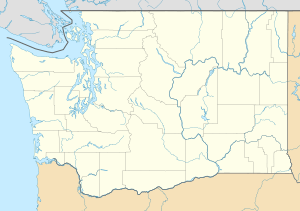Dungeness National Wildlife Refuge facts for kids
Quick facts for kids Dungeness National Wildlife Refuge |
|
|---|---|
|
IUCN Category IV (Habitat/Species Management Area)
|
|

Aerial view of Dungeness National Wildlife Refuge
|
|
| Location | Clallam County, Washington, United States |
| Nearest city | Sequim, Washington |
| Area | 772.52 acres (312.63 ha) |
| Established | 1915 |
| Governing body | U.S. Fish and Wildlife Service |
| Website | Dungeness National Wildlife Refuge |
The Dungeness National Wildlife Refuge is a special place for nature near Sequim. It is located in Clallam County, in the state of Washington, right on the Strait of Juan de Fuca. This refuge covers about 772.52 acres. It includes the famous Dungeness Spit, Graveyard Spit, and parts of Dungeness Bay and Harbor.
Dungeness Spit is one of the longest natural sand spits in the world. It stretches about 6.8 miles (11 km) and is very narrow. A lighthouse, built in 1857, stands near the end of the spit. You can reach Dungeness Spit through a Clallam County Park. This park has hiking trails, picnic spots, and a campground. President Woodrow Wilson officially made it a National Wildlife Refuge on January 20, 1915. Dungeness is one of six refuges in the Washington Maritime National Wildlife Refuge Complex.
Contents
Amazing Animals and Their Homes
The Dungeness National Wildlife Refuge is home to many different animals. More than 250 kinds of birds and 41 types of land mammals live here. The bay and the estuary (where the Dungeness River meets the sea) are perfect for Waterfowl, wading birds, Shellfish, and harbor seals.
Fish and Migratory Birds
Fish like Chinook, Coho, pink salmon, and chum salmon swim in Dungeness Bay and Harbor. These are called anadromous fish, meaning they live in the ocean but return to fresh water to lay their eggs. Many kinds of waterfowl stop here each fall on their way south for winter. They also stop again in the spring when they fly north. Lots of waterfowl spend the entire winter in this area.
Dungeness Bay and Harbor are especially important for black brant geese. You can see them from late October to early May. In April, there can be as many as 3,000 to 5,000 of these geese! Shorebirds and wading birds find food and rest along the water's edge.
Seals and Shellfish
Harbor seals come to the end of Dungeness Spit to rest and have their babies. The tideflats, which are muddy or sandy areas uncovered at low tide, are full of crabs, clams, and other shellfish.
An Important Bird Area
The National Audubon Society recognizes Dungeness NWR as an Important Bird Area. This means it's a very special place for birds. It's important worldwide because many birds that stop here travel huge distances. Some breed as far north as Alaska and fly all the way to South America! The Dungeness area is also a key "spring staging area." This is where large groups of birds stop in the spring to eat a lot and build up energy for their long migration flights.
Fun Things to Do and Rules to Follow
The main activities you can enjoy at the refuge are watching wildlife and taking photos. You can also learn a lot about nature here.
Protecting Wildlife While Having Fun
To make sure animals always have a safe place to rest and find food, some activities are only allowed in certain areas or at specific times. For example, jogging, swimming, and other beach activities are limited. This helps protect the animals and their homes.


